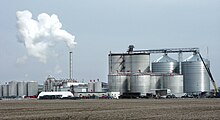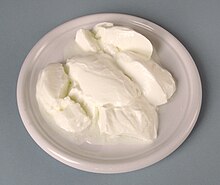fermentation
Fermentation or fermentation (from Latin fermentatio , from fermentare , "fermenting, swelling", from fermentum "loosening the earth, uplifting, fermentation ; fermentation substance , sourdough") describes the microbial or enzymatic conversion of organic substances into acid in biology and biotechnology , Gases or alcohol . Fermentation is consciously used in biotechnology as the conversion of organic matter outside of living organisms. This is done either by adding bacteria , fungal or other biological cell cultures or by adding enzymes (ferments) that carry out the fermentation as part of their enzyme-catalyzed metabolism. Some of these microorganisms are already naturally present on the raw materials, for example during spontaneous fermentation . Nevertheless, pure-bred cell cultures are added in industrial fermentation in order to better control the fermentation and to exclude undesired by-products.
definition
Originally with fermentation , a fermentation under air exclusion referred. Louis Pasteur coined the expression fermentation, c'est la vie sans l'air , 'Fermentation is life without air' .
Today, fermentation in biotechnology includes any microbial or enzymatic conversion of organic substances, including those with an oxygen supply.
Examples of types of fermentation:
- Anaerobic fermentation as a biotic energy metabolism without the use of oxygen.
- Aerobic processes such as acetic acid fermentation are also known as oxidative fermentation .
- Other changes in biotic raw material through microbial or autolytic enzymatic processes in which oxygen is not or only partially excluded. For example, introduced for the fermentation of tobacco leaves to smoke tobacco , fermentation of cocoa pods (including its seeds) for the production of cocoa powder and chocolate as well as young herring maturation.
- In biotechnology in general, the controlled production of biotic metabolic products, with or without the inclusion of oxygen.
- Submerged fermentation is the term used for processes in liquids and dispersions .
Fermentation is not used in a broader sense in all scientific disciplines as it is in biotechnology today. In biochemistry and metabolomics , the term “fermentation” continues to denote only an anaerobic process, also in English. To avoid confusion in German, the term cultivation is sometimes used.
The enzymology is the research field of fermentation.
The reactors are also known as fermenters. Various medical products such as insulin , hyaluronic acid , streptokinase and a large number of antibiotics , for example penicillin, can be synthesized on an industrial scale in bioreactors , partly with the help of microorganisms , partly with cell cultures (mostly suspension cells ). The microorganisms are able - if necessary after genetic modification - to form substances that are difficult to produce chemically.
Areas of application
Fermentation in food and luxury food production

In food production, the fermentation plays a central role in the production and preservation of food, such as the production of sauerkraut , kimchi , Tsukemono , miso , natto , tempeh or Ontjom . Furthermore, the aromas develop , as in soy sauce and fermented beverages, the tannins are broken down, as in tea , cocoa , coffee and tobacco . Other processes are the production of dairy products such as cheese or yoghurt , the production of tofu or raw sausage ( e.g. salami ) and, ultimately, the production of alcoholic beverages such as beer , wine or whiskey .
Manufacture of dairy products and lactofermented vegetables
A number of foods are made directly through lactic acid fermentation. This mainly includes sour milk products such as sour milk, yogurt, kefir and buttermilk . These are made by inoculating pasteurized milk with starter cultures of lactic acid bacteria. Traditionally, these products were made from raw milk, whereby the lactic acid bacteria settled in the air and reproduced naturally, thus starting fermentation. Today this production does not play a role due to the large quantities required. The legal situation in Germany, which prohibits the sale of raw milk to processing companies, also makes a decisive contribution to this. Due to the modern way of feeding cows, incorrect fermentation of the milk is more likely. This is why, for example, for many Swiss raw milk products valued by gourmets, there are strict regulations for largely natural feeding by grazing and giving hay in winter, which is intended to prevent incorrect fermentation of the milk for the production of raw milk products. Since the range of bacteria that can settle from the air is greater than those from the specified doses in mass production, there are differences in the fermentation process and, as a result, in the variety of flavors. Other products include lactofermented vegetables such as sauerkraut , pickles , tsukemono , tsa tsai , torshi or kimchi as well as sourdough and corresponding sourdough products. Silages, fresh feed made durable through fermentation, are based on lactic acid fermentation.
Fermentation of tea leaves
The tea leaves are squeezed by rolling and the plant cells are partially destroyed. In industrial production, the crush, tear, curl process is mostly used. The enzymes separated in the intact cell (especially phenol oxidases ) and other ingredients of the tea plant (especially the polyphenols ) come together and react with oxygen. This gives rise to the dark colored polyphenols and flavorings. The process takes about three hours. In contrast to black tea , oolong tea is only fermented briefly and green tea is not fermented.
Fermentation of raw tobacco
Fermentation of tobacco is a fermentation process with which a ready-to-use tobacco is produced from dried raw tobacco. The nicotine content is reduced and the leaf's own protein compounds, which would mask the characteristic aroma of the individual varieties when smoked, are broken down.
After the respective batch of tobacco has been put together (at least 1000 kilograms), the fermentation process begins by itself or is set in motion by the supply of heat. The ideal process temperature is between 50 ° C and 60 ° C, higher temperatures damage the tobacco quality. In natural fermentation, the tobacco stacks are rearranged four to five times, from the edge of the stack to the middle of the stack and vice versa. It takes four to six months for all the leaves to ferment evenly.
Production of lactofermented fish
Fish is also fermented. examples are
- Funazushi - Japanese fermented female Nigoro-Buna ( crucian carp )
- kæst skata - Icelandic fermented ray
- Hákarl - Icelandic fermented fish
- Surstromming - Swedish, stored, salted and fermented fish
- Pla Raa - Thai, stored, salted and fermented fish
Fermentation of marijuana
Also, marijuana is usually fermented to the smoking enjoyment due to improved taste, less irritation to the throat and a higher THC improve stake.
Technical fermentation

The main area of application for fermentation is technical biotechnology for the production of various fermentation products. The products range from bioethanol to amino acids , organic acids such as lactic acid , citric acid and acetic acid , to enzymes such as phytase , antibiotics and other pharmaceutical products to biomonomers and polymers such as polyhydroxyalkanoates . Such technical products are polyhydroxyalkanoates or polyhydroxybutyric acid (PHB). Technical bioethanol, for use as biofuel , is currently the main product of the fermentation industry alongside beer and yeast production as well as biogas .
The raw materials are mainly starch and sucrose substrates for production by bacteria or fungi . In Brazil , bioethanol is mainly obtained from sugar cane based on sugar , while corn is the main raw material in the USA. According to the German bioethanol industry, almost two thirds of bioethanol in Germany is obtained from starchy plants, especially wheat. The production usually runs independently of the substrate, so in almost all fermentation processes both starch and sucrose and various other sugary products can be used, especially syrup and molasses . Also cellulose as a main component of the wood is a sugar polymer as the alternative substrate is under discussion for future applications, especially for cellulose-ethanol as well as for use in the biorefinery .
Biogas production
The production of biogas by fermenting biomass in biogas plants is also a fermentation process. This product is used to generate bioenergy . With the help of bacteria, a gas mixture with the main components methane (CH 4 ) and carbon dioxide (CO 2 ) as well as traces of nitrogen (N 2 ), oxygen (O 2 ), hydrogen sulfide (H 2 S), hydrogen (H 2 ) and ammonia (NH 3 ) are produced. Most of the time, biogas treatment is used for cleaning. The proportion of methane produced during fermentation is important for biogas, as its combustion releases most of the energy.
Also, landfill gas and sewage gas are formed at the position indicated as fermentation or digestion anaerobic decomposition of organic material. These gases are sometimes summarized under the names digester gas or biogas.
Bioreactors

Microorganisms in particular can be cultivated in so-called bioreactors or fermenters. These are containers in which the reaction conditions are controlled and optimized. In this way, the cultivated organisms produce the desired substances under optimal conditions or in higher concentrations. In the reactors, different to parameters , including pH , temperature , oxygen feed, nitrogen feed, glucose content or stirrer are controlled settings.
Since the organisms that can be used have very different requirements, a wide variety of fermenter types are available.
- Stirred tank reactors
- Loop reactors
- Airlift reactors
- Photobioreactors for the cultivation of algae and plants
literature
- R. Stürmer, M. Breuer: Enzymes as catalysts. Chemistry and biology go hand in hand . In: Chemistry in Our Time . tape 40 , 2006, pp. 104–111 , doi : 10.1002 / ciuz.200600379 .
Web links
- Fermentation of cocoa beans (PDF; 2.1 MB)
Individual evidence
- ^ Latin etymological dictionary (= Indo-European library. Department 1: Collection of Indo-European textbooks and handbooks. Series 2: Dictionaries. 1). Winter, Heidelberg 1906; 3rd edition revised by J. B. Hofmann there in 1938 (2 volumes and register volume by Elsbeth Berger from 1956); Reprints, declared as 4th to 6th edition, ibid 1954 to 2008, ISBN 978-3-533-00668-8 (Volume 1: A - L ), ISBN 978-3-8253-0669-4 (Volume 2: M - Z ), Volume 1, p. 482 f.
- ^ IUPAC. Compendium of Chemical Terminology. doi : 10.1351 / goldbook .
- ^ Rolf D. Schmid: Pocket Atlas of Biotechnology and Genetic Engineering. 2nd edition Wiley-VCH, Weinheim 2006; ISBN 978-3-527-31310-5 , pp. 12-13.
- ↑ Ramasamy Shanmugasundaram Senthil Kumar, Subramanian Murugesan, Govindasamy Kottur, Daniel Gyamfi: Black Tea: The Plants, Processing / Manufacturing and Production . In: Victor R. Preedy (Ed.): Tea in Health and Disease Prevention . Academic Press , 2013, ISBN 978-0-12-384937-3 , pp. 41-57 , doi : 10.1016 / b978-0-12-384937-3.00004-5 .
- ^ Hans G. Adrian, Rolf L. Temming, Arend Vollers: Das Teebuch. History and stories. Cultivation, production and recipes . VMA, Wiesbaden 1990, ISBN 3-928127-01-2 .
- ^ Jan Koolman: Coffee, Cheese, Caries .... John Wiley & Sons, 2012, ISBN 978-3-527-64110-9 ( limited preview in Google book search).
- ↑ Federal Association of the German Bioethanol Industry e. V. (BDBe): Market data ( memento of the original dated November 11, 2012 in the Internet Archive ) Info: The archive link was inserted automatically and has not yet been checked. Please check the original and archive link according to the instructions and then remove this notice. , accessed March 26, 2011.


